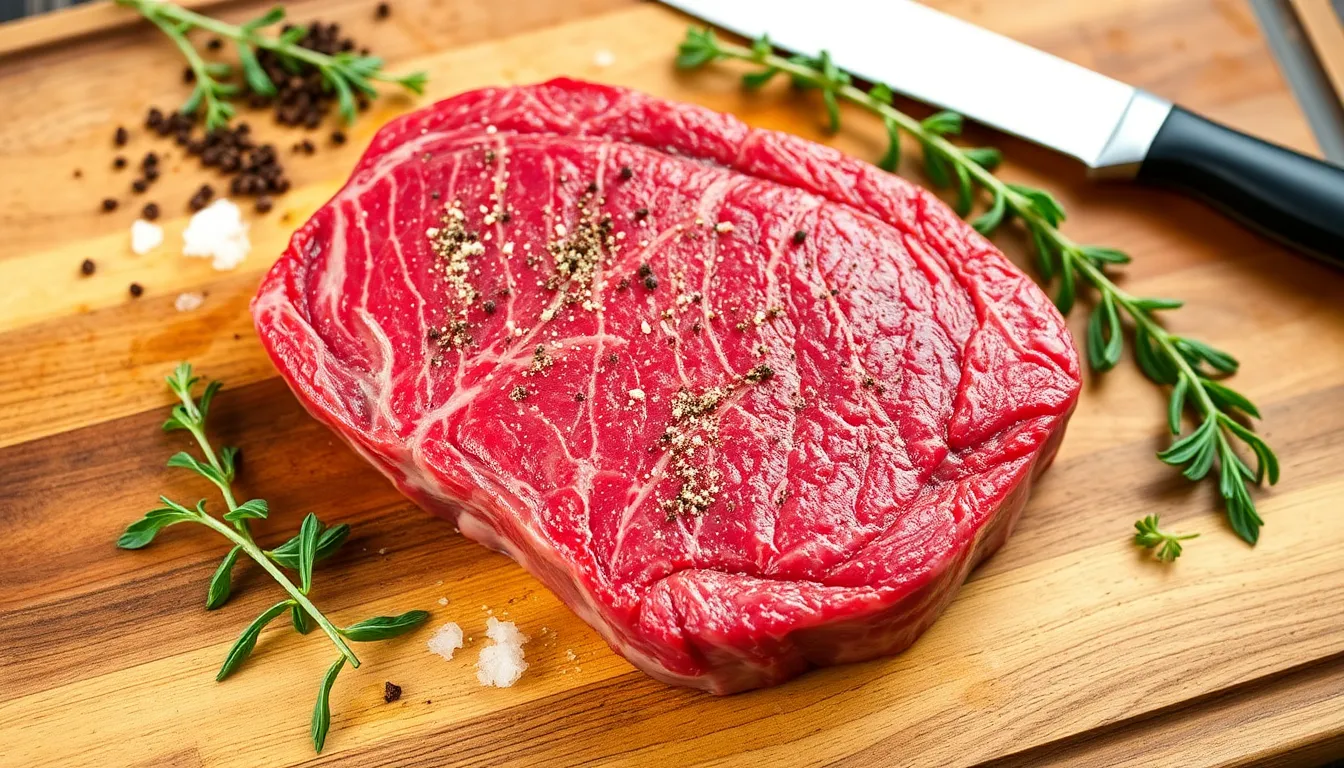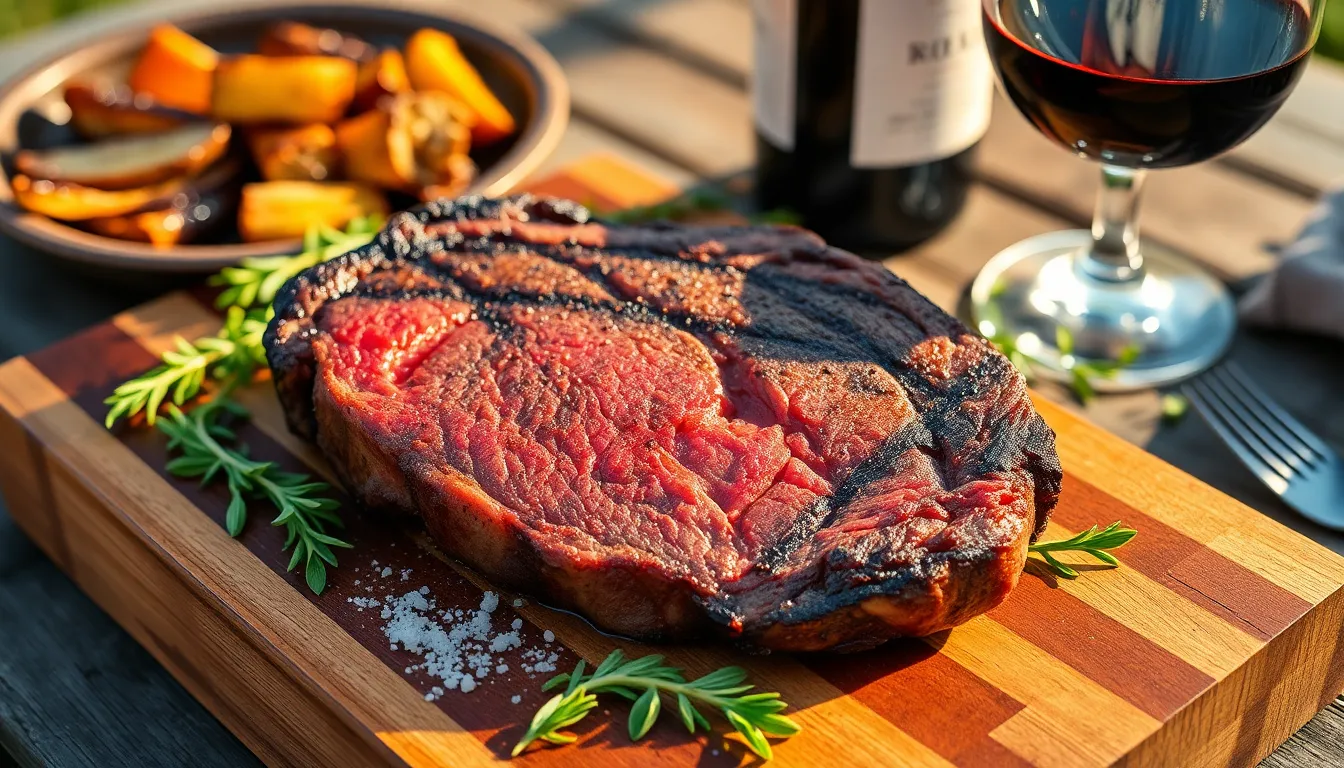When it comes to steak, the ribeye reigns supreme, and achieving that perfect medium rare temperature is like hitting the culinary jackpot. Picture this: a beautifully marbled cut of meat, sizzling on the grill, exuding mouthwatering aromas that make your taste buds dance. But wait—what’s the magic number for that ideal doneness?
For steak lovers, medium rare isn’t just a temperature; it’s a way of life. At around 130 to 135 degrees Fahrenheit, it’s that sweet spot where the meat is tender, juicy, and bursting with flavor. So grab your thermometers and aprons, because mastering the art of cooking ribeye to medium rare will elevate your grilling game and impress anyone lucky enough to snag an invite to your next barbecue. Who knew steak could be both a science and a delicious adventure?
Table of Contents
ToggleUnderstanding Ribeye Steak
Ribeye steak stands out as a favorite among steak enthusiasts due to its rich flavor and tenderness. Known for its marbling, this cut delivers both juiciness and a delightful taste experience.
What Makes Ribeye Special
Flavor richness sets ribeye apart from other cuts. Intramuscular fat, or marbling, enhances taste and contributes to the steak’s buttery texture. Grilling or pan-searing brings out its inherent juiciness, creating a satisfying crunch on the outside while keeping the inside tender. Aroma plays a significant role when cooking, with the smoky scent enticing food lovers. Each bite provides a balance of flavor, making it ideal for those who appreciate a delicious steak experience.
Cuts and Grades of Ribeye
Several ribeye cuts exist, each with unique characteristics. The Standard Cut includes the eye and central portion, while the Cap Steak features the flavorful outer edge. Other options like the Tomahawk Ribeye highlight impressive presentation, with long bones extending from the meat. Grading also matters; USDA Prime represents the highest quality, offering abundant marbling. USDA Choice follows, providing good marbling and tenderness. Quality grading reflects the taste and texture expectations diners can anticipate from their ribeye steak experience.
Preparing Ribeye Steak

Preparing ribeye steak requires careful selection and seasoning to achieve the best flavor and texture. Mastering these steps sets the foundation for an exceptional dining experience.
Selecting the Right Ribeye
Choose ribeye steaks with excellent marbling. Look for USDA Prime grade for the highest quality, which guarantees tenderness and rich flavor. Opt for cuts that are at least one inch thick, allowing for even cooking. Different cuts like the Standard Cut, Cap Steak or Tomahawk Ribeye provide distinct taste sensations. Examine color; bright red indicates freshness, while avoid steaks that appear dull or brown. Each factor contributes to a superior ribeye experience.
Seasoning Your Steak
Enhance the natural flavor of ribeye with simple seasoning. Start with a generous amount of kosher salt, which brings out its robust taste. Freshly cracked black pepper adds a subtle kick without overwhelming the meat. Consider incorporating additional spices like garlic powder or smoked paprika for depth. Apply seasoning generously, ensuring all surfaces are covered, allowing it to penetrate the meat effectively. Rest the seasoned ribeye for at least 30 minutes before cooking. This timeframe lets flavors meld while the steak reaches room temperature, resulting in a juicier, more flavorful bite.
Cooking Ribeye Steak to Medium Rare
Achieving the perfect medium rare ribeye steak relies on precise temperature control. The target range lies between 130 to 135 degrees Fahrenheit.
Ideal Temperature for Medium Rare
Medium rare steaks display a warm red center. At this temperature, the proteins retain moisture, ensuring tenderness. Using a meat thermometer provides accurate readings. For optimal results, insert the thermometer into the thickest part of the steak after a cooking period of around 5 to 7 minutes per side. This method prevents overcooking. Once the temperature is reached, let the steak rest for about 5 to 10 minutes to allow juices to redistribute, enhancing the overall flavor and texture.
Techniques for Cooking
Grilling offers a classic approach to cooking ribeye steak. Preheating the grill to high allows for a perfect sear. Searing one side for a few minutes develops desirable crusting, followed by flipping the steak to sear the opposite side. Pan-searing primes another method, using a heavy skillet heated over medium-high heat. Adding a touch of oil helps prevent sticking. Some cooks prefer finishing cooking in an oven for more even heat distribution. Regardless of the method chosen, frequent monitoring of the steak’s temperature ensures it meets the medium rare standard without exceeding it.
Testing Doneness
Understanding how to test doneness ensures a perfect medium rare ribeye steak. Achieving this temperature requires specific techniques that enhance the overall flavor.
Using a Meat Thermometer
A meat thermometer provides the most accurate way to gauge internal temperature. Insert the probe into the thickest part of the steak, avoiding bone or fat. For medium rare, the thermometer should read between 130 to 135 degrees Fahrenheit. Continuous monitoring enhances the chance of reaching the desired doneness. Removing the steak from heat once it hits this range prevents overcooking. Letting the steak rest for 5 to 10 minutes after cooking allows juices to redistribute. A properly used thermometer guarantees that your ribeye steak remains juicy and tender.
Visual Cues for Medium Rare
Visual cues can aid in determining whether the steak is medium rare. Observing the steak’s surface is essential; it should appear rich brown with some caramelization. The edges remain firm while the center holds a slight bounce. A warm red center indicates the perfect doneness. Pressing lightly on the steak offers insight; it should feel soft but not mushy. Additionally, juices that run clear or slightly pink signal the steak’s readiness. These visual indicators complement the thermometer readings, ensuring a consistently delicious result.
Serving Suggestions
Pairing the right sides and wines elevates the ribeye steak experience to new heights. Roasted vegetables like asparagus and Brussels sprouts complement the rich flavor of ribeye perfectly. A fluffy baked potato or creamy mashed potatoes also enhances the meal. For wine enthusiasts, full-bodied reds such as Cabernet Sauvignon or Malbec harmonize wonderfully with the steak’s robust taste. An oaked Chardonnay can provide an interesting contrast, balancing the meat’s richness.
Presentation plays a crucial role in enhancing the dining experience. Thick slices of ribeye steak should be displayed artfully on a warm plate. Adding a sprig of fresh herbs, like rosemary or thyme, brings visual appeal and aroma. Drizzling a little balsamic reduction or herb-infused oil can enhance the overall aesthetic. Accompanying sides can be arranged neatly beside the steak, creating an inviting plate. Quality and presentation encourage guests to enjoy not just the flavors but the entire experience.
Achieving the perfect medium rare ribeye steak is a rewarding endeavor that elevates any meal. With its rich flavor and tender texture enhanced by careful cooking techniques and precise temperature control, the ribeye stands out as a favorite among steak enthusiasts. Mastering the art of cooking this cut not only impresses guests but also enriches the overall dining experience.
By focusing on high-quality marbling and proper seasoning, anyone can create a delicious ribeye steak that delights the senses. Pairing it with complementary sides and wines further enhances the meal, ensuring each bite is memorable. Embracing these practices will undoubtedly lead to steak nights that are both satisfying and enjoyable.











